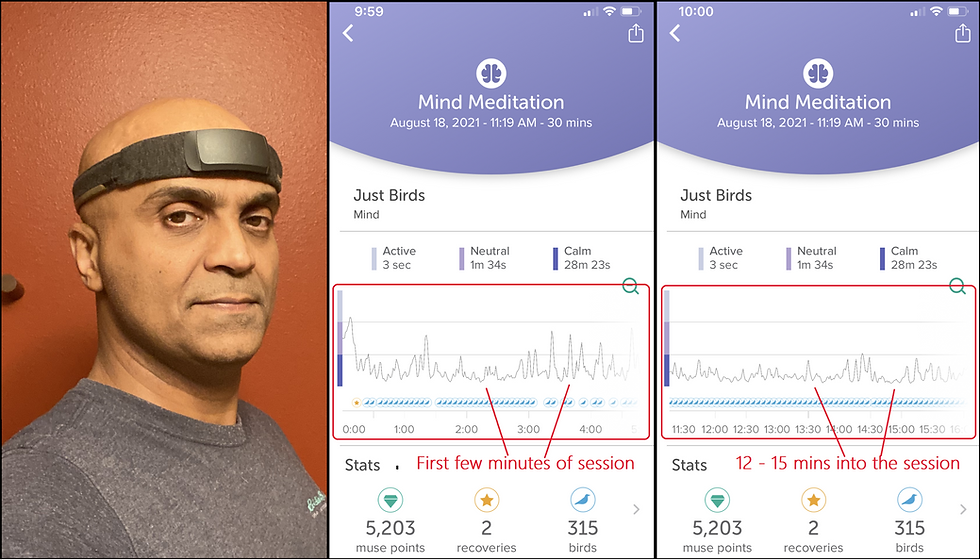Learning to Meditate with a little help from Movies and Milarepa the Murderer
- Kris Shankar
- Aug 21, 2022
- 4 min read

Some months back, I was trying to convey my experience at a 10-day silent meditation retreat to a former workmate and friend, Jean-Christophe or JC as he goes by. “I get all the relaxation I want from working in the garden or building stuff with my hands”, said JC, “sitting on a cushion doing nothing for days on end sounds awfully boring and doesn’t sound like my cup of tea”. I promised JC that I would tease out the connection between relaxation and meditation in a future post, so here goes.
Attention and Awareness: The Keys to Meditation
First, let’s agree on what meditation is. The Tibetan Buddhist murderer-turned-adept Milarepa* (1040–1123) defines meditation tersely as “luminosity without fixation”, which can be translated as an alert yet relaxed presence of mind. Milarepa means a continuous, unbroken attention** to the Now or present moment, while simultaneously being aware of ourselves. This attention to the present moment must be accompanied by a non-striving for pleasant experiences and non-rejection of negative experiences — in other words, there must be no fixation on your present circumstances, good or bad.
How Movies Can Help You Grok Meditation
If Milarepa’s luminosity without fixation seems a little too abstract for you, try this experiment. The next time you watch a movie, instead of losing your mind in the movie, remain keenly aware of the fact that you are watching moving images on a screen. Simultaneously, keep your attention partly on your breath or the sensation of your body in contact with the seat under you. You’ll find it very difficult to do this for more than a few seconds. The mind’s tendency to get sucked into the story you are watching, not to observe it dispassionately — after all, what’s the fun in that?! It is a stark illustration of how we live out most of our waking moments mindlessly, caught in the whirlpool of our thoughts and internal chatter. If you can watch a movie*** for at least 20–30 minutes mindfully without getting fixated on the characters and the plot, you’ve had a small taste of Milarepa’s luminosity without fixation.
The Emptiness of Your Own Mind
There’s a second benefit to the above exercise. With sufficient practice, you get to see that your thoughts and emotions are like a movie — moving pictures projected on the screen of your mind. Not that they are unreal, but that your mind is often regurgitating the same plot again and again in different forms “my manager is out to get me”, “my spouse was rude to me today”, “I am worried about my finances”, ‘will my kid get into college”, so on and so forth. For most of us, these tapes are playing over and over even when we are in the garden, even when we are working with our hands. Except that we are not really aware of them. If you are really relaxed and mindful, you are able to see these thoughts as they arise, and they lose their power and fade away. And then you are able to see your mind as truly empty in the space between thoughts. Milarepa calls this the wisdom (or knowledge) of being empty. Without this insight, you always run the risk of fixating upon certain thought patterns at a level just below your awareness. Worse, these thought patterns will rise up and take over your mind when you react to office politics, the driver who cuts you off on the freeway, or that news article about the FBI Raid on Mar-a-Lago.
Taking Meditation into the Real World
Remaining aware and alert is far from easy, but it is like learning to run a marathon or play the piano. With sufficient practice, you can build the muscle to be in the Now, the present moment, with less effort, both within and without the confines of the meditation hall. There’s no free lunch and there’s plenty of boredom along the way. There is no fun in watching a movie while remaining aware all the time that it’s just a bunch of moving images on the screen. The thing is, the real world isn’t a movie. There are going to be many more situations and circumstances that go against you than in your favor. You can react to these situations mindlessly or use your newfound powers of mindfulness to respond meaningfully or calmly ride it out. Milarepa calls this conduct that is a continual flow free of attachment.
Is Relaxation the same as Meditation?
Coming back to my friend JC’s question, if you are meditative in your every wakeful moment, you are relaxed. However, if you are relaxing by spending time in the garden, sitting on a beach or watching a movie, you are not necessarily meditative…unless you can carry that state of relaxation back into the everyday world. JC, I hope I answered your question.
*From Wikipedia: Milarepa was born in western Tibet to a prosperous family. When his father died, his family was deprived of their wealth by his aunt and uncle. At his mother’s request, Milarepa left home and studied sorcery to take revenge, killing many people. He eventually turned to Buddhism and became one of Tibet’s greatest teachers.
**Attention is similar to concentration but differs in that you are a keen but non-interfering observer, whether you are directing your attention to your breath, your body or your surroundings. Concentration implies a sense of doership, which is not a good thing when you are meditating.
***The 2012 political thriller Argo starring Ben Affleck is the only movie I have watched end to end with both awareness and attention. I enjoyed it, but in a different sort of way :)




Comments